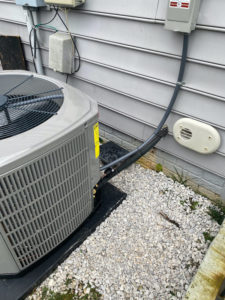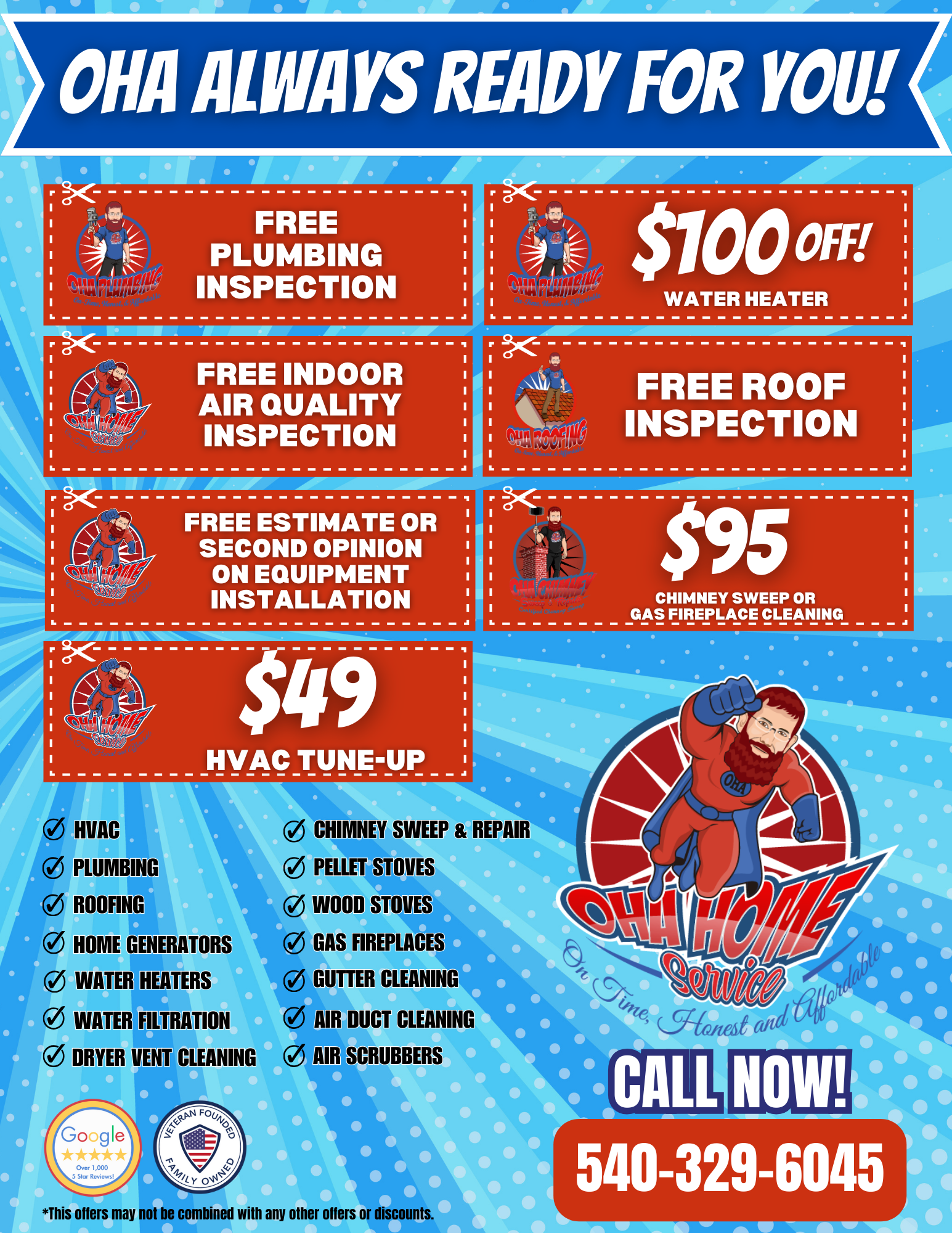Your HVAC system is a high voltage electrical system that may also have gas or heating oil. The combination of electricity and gas make the need for proper caution paramount. There are simple regular maintenance items that can be performed by the homeowner, but there are several items for HVAC Maintenance that should only be done by a qualified technician. The general rule of thumb is this; if you know what you are doing and you are not opening the unit or messing around with the electrical or gas systems, then you are probably fine. But, when in doubt, call a qualified technician. Don’t risk damaging your property or hurting someone in your home.

List of Items to Complete the Spring HVAC Maintenance:
1. Clean the area around the outdoor unit.
Make sure the immediate area around your outdoor unit is free of leaves, sticks, branches & other debris that may have accumulated over the winter months. Anything cluttered around your system could prevent or restrict air flow, reducing the life of your HVAC system or causing it to breakdown or overheat. If you are outside with a water hose, then take a minute and lightly spray off the outdoor unit, be careful not to use too much pressure as you do not want to bend the fins. The difficulty of the task is low; this is a good one for the homeowner.
2. Check the condensate line.
Most HVAC units have a condensate line that drains to the outside of the home, make sure the condensate line is not clogged, and the area around the condensate line is clear so water can flow freely. You don’t want to flood your home. If you notice that the line is partially or fully clogged, then take something long and skinny like a drain cleaner and free the blockage. Run water through the drain to make sure the obstruction is gone. The difficulty of this task is moderate for the homeowner to complete; if you are unsure which is the condensate line, then let the technician do this for you.
3. Check the condensate pump.
The condensate pump removes water from the air conditioner when a floor drain is not available. Check that the condensate pump is plugged into the electrical outlet and operating correctly. Otherwise, you could end up with a bit of a flood in your house. Unplug the pump and remove the top of the housing. Clean the reservoir section, sterilize with bleach, and reassemble the pump; this will keep sediment and algae from plugging up the pump.
4. Change the air filters whenever they are dirty.
Changing your HVAC system’s air filters reduces your energy bills, improves the air quality of your home, and extends the life of your system, it is also a normal part of the HVAC maintenance. Clogged and dirty filters damage your equipment and cause possible malfunctions. Customers always want to know how often their air filters should be changed, and the real answer is whenever they get dirty. Check the air filters every month. We provide free air whistles to our customers. Air whistles make a whistling sound when the filter needs to be changed. If we have not given you air whistles, just ask our technician the next time he is at your house, and he will be happy to provide them to you, free of charge. Changing air filters is an easy task for the homeowner to complete if they can safely use a ladder.

5. Check exhaust vent openings.
Exhaust vent openings may have missing, damaged, or clogged screens. Vent pipes are inviting to birds and rodents, particularly in the winter, as well as insects in warmer weather. Broken or clogged vent screens can reduce the efficiency of your furnace as well as your clothes dryer. We do not recommend that homeowners try to replace missing or damaged screens themselves. Not all screening products are created equal, and you could create problems for your furnace or dryer. It is best to contact a technician to install the proper screen.
6. Open vents in your crawl space.
Opening the vents in your crawl space in the spring will allow outside air to circulate. Fresh air helps to prevent moisture buildup, which could cause mold, mildew, and eventual wood rot. We recommend doing this only before summer humidity starts. Opening vents is simple for the homeowner to do if they know where the vents are located and do not mind crawling under their house to open the vents. I don’t like spiders and snakes, so this is not one that I would personally do.
7. Turn off your humidifier when your furnace is not in use.
A humidifier adds moisture to the dry air to make the environment more comfortable, primarily during the winter. An air conditioner removes excess humidity from the moist air we have in Summer. If you don’t turn off your humidifier, then your air conditioner will not cool and dehumidify your home correctly, causing your HVAC system to work harder and increase your utility bills.
8. Turn off the pilot light to your gas fireplace.
You don’t use your fireplace in the summer, so why waste the money on fuel? The pilot light may seem small and insignificant, but it does produce heat. The last thing you want in your home in the Spring and Summer is more heat, especially when you are running your air conditioner. Aesthetically speaking, the longer the pilot light is lit, the more soot will build upon your fireplace’s glass front. The additional benefit is that you will also save money by not burning gas. I caution homeowners about touching the gas controls. If you are comfortable doing this and have experience doing it, then be safe, otherwise, have a technician do it for you.
9. Turn off the propane at the tank.
If your fireplace runs on propane, and it is your only household appliance that runs on propane, then turn off the propane at the tank. If you have other household appliances that run on propane, then you cannot turn off the propane tank. If you are comfortable turning off the propane tank, then this is an easy task, but if you are unsure, let the technician do it for you.
10. Open the windows to let fresh air into your home.
If you do not suffer from spring allergies, open the windows on breezy days. Bringing in the fresh air of spring can help eliminate closed-up winter stuffiness and drive out unpleasant odors that may have accumulated in your home. Make sure your window screens are in good condition, so you don’t allow bugs to come in on the breeze. Adjust your thermostat so that your HVAC system doesn’t come on while your windows are open.
11. Set the thermostat for the season.
Make sure that your thermostat is set correctly for the season. If you have a programmable thermostat, then you may not have to worry about this once you have the thermostat set properly. If you have an old-style thermostat, it may make sense to look at purchasing a programmable thermostat as they save energy and money. They are also able to keep your home more comfortable than most traditional thermostats as programmable thermostats have more settings and are automated. Adjusting the thermostat is something most homeowners can do without a technician. Programmable thermostats can provide energy savings and allow for remote control of the unit through a smartphone. There are even programable thermostats that will enable your HVAC company to monitor the status of your system. If the company notices a problem, they can fix it; often before you are even aware, there was an issue.
12. System freezing or producing ice.
If the system is freezing over or producing ice, then your technician is going to check to make sure that your unit has the proper amount of refrigerant. If the system is low on refrigerant, then the technician will check for leaks and add the necessary amount needed and check the performance of the system. If you have an older system that uses R-22, then the technician will discuss options available to you. R-22 is a type of refrigerant no longer legally produced in the USA, and the use of R-22 is severely restricted. The EPA has designated R-22 as environmentally dangerous.
13. Check the electrical components of your system.
Your technician will check the electrical components of the system to make sure they are operating correctly. If the technician notices any broken, frayed, or heat worn (melted) components, then the technician will suggest replacing the necessary parts as these issues can have an increased risk of causing a fire or breaking down. Often, when a component fails, it has a wearing effect on other parts that are attached to it. Your technician will check the parts that are attached to the failed component for wear and tear. Because this deals with the electrical system, this is not an item that homeowners should address.
14. Check the furnace.
The technician will check your furnace to make sure there are no signs of gas leaking, rusted parts, or broken heat exchangers. Leaking gas is an obvious fire hazard and should be fixed immediately. Rusted parts and cracked heat exchangers can have an impact on the safety of the equipment and its operation. Cracked heat exchangers and leaking gas are items that the technician will need to service for you.
15. Belts, pulleys, and parts.
During the HVAC maintenance, the technician will inspect belts, pulleys, and parts to make sure they are not worn and in jeopardy of failing and use a proper lubricant on all necessary components. If belts, pulleys, or pieces show wear, the technician will discuss options to fix or replace where appropriate as well as check the parts that are attached to the worn part to make sure there has not been any collateral damage.
Remember to only do the items that are within your skill level, comfort zone and are safe for you to do. A good HVAC company will be more than happy to do all of these for you when they perform the HVAC maintenance.










